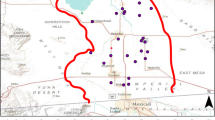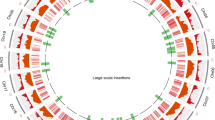Abstract
Populations of weed beets have expanded into European sugar beet production areas since the 1970s, thereby forming a serious new weed problem for this crop. We sampled seeds in different French populations and studied mitochondrial DNA, chloroplast DNA and life-cycle variability. Given the maternal inheritance of the mitochondrial and chloroplastic genomes and the nuclear determinism of the annual habit, we were able to determine the maternal origin and evolution of these weed beet populations. Our study shows that they carry the dominant allele “B” for annual habit at high frequency. The main cytoplasmic DNA type found in northern weed beet populations is the cytoplasmic male-sterile type characteristic of sugar beets. We were able to determine that these populations arise from seeds originating from the accidental pollinations of cultivated beets by adventitious beets in the seed production area, which have been transported to the regions where sugar beets are cultivated. These seeds are supposedly the origin of the weed forms and a frequently disturbed cultivated environment has selected for annual habit and early flowering genotypes. We discuss the consequences of the weed beet populations for the breeding, seed production and release of herbicide-resistant transgenic sugar beets.
Similar content being viewed by others
References
Abbott RJ (1992) Plant invasions, interspecific hybridization and the evolution of new plant taxa. TREE 7:401–405
Barrett SCH (1984) Crop mimicry in weeds. Econ Bot 37:255–282
Boiteau R, Christmann J (1977) Les betteraves mauvaises herbes-situation actuelle et importance du problème. In: Weickmans L (ed) 40th Winter Cong Int Inst Sugar Beet Res. IIRB, Brussels, pp 87–107
Bonavent JF, Geny A, Bessone L, Bervillé A, Denizot JP, Brian C (1989) A possible origin for the sugar beet cytoplasmic male sterility called Owen. Genome 32:322–327
Carsner E (1928) The wild beet in California. Facts Sugar 23:1120–1121
De Bock ThSM (1986) The genus Beta: domestication, taxonomy and interspecific hybridization for plant breeding. Acta Hortic 182:335–343
De Greef W, Delon R, De Block M, Leemans J, Booterman J (1989) Evaluation of herbicide resistance in transgenic crops under fields conditions. Bio/technology 7:61–64
Desprez M (1980) Observations et remarques sur la montée à graines chez la betterave sucrière. CR Seances Acad Agric Fr 66:44–53
Dewey RE, Levings CS, III, Timothy DH (1985) Nucleotide sequence of ATPase subunit 6 gene of maize mitochondria. Plant Physiol 79:914–919
Dhalluin K, Bossut M, Bonne E, Mazur B, Leemans J, Botterman J (1992) Transformation of sugar beet (Beta vulgaris L.) and evaluation of herbicide resistance in transgenic plants. Bio/Technology 10:309–314
Ellstrand NC, Hoffman CA (1990) Hybridization as an avenue of escape for engineered genes. Bio-Science 40:438–442
Evans A, Weir J (1981) The evolution of weed beet in sugar beet crops. Kulturpflanze 24:301–310
Forcioli D, Saumitou-Laprade P, Michaelis G, Cuguen J. Chloroplast DNA polymorphism revealed by a fast, nonradioactive method in Beta vulgaris subsp maritima. Mol Ecol (in press)
Ford-Lloyd BV (1986) Infraspecific variation in wild and cultivated beets and its effect upon infraspecific classification. In: BT Styles (ed) Infraspecific classification of wild and cultivated plants. Syst Assoc Spec Vol 29:331–334
Ford-Lloyd BV, Hawkes JG (1986) Weed beets, their origin and classification. Acta Hortic 82:399–104
Harlan JR (1987) Les plantes cultivées et l'homme. Agence de Coopération Culturelle et Technique et Conseil International de la langue Française, Paris
Horsney KG, Arnold MM (1979) The origins of weed beet. Ann Appl Biol 92:279–285
Johnson RT (1954) The effect of successive seed increases by the overwintering method on the non-bolting characteristics of two relatively non-bolting varieties of sugar beets. Proc Am Soc Sugar Beet Technol 8:79–83
Johnson RT, Burtch LM (1959) The problem of wild annual sugar beets in California. Proc Am Soc Sugar Beet Technol 10:311–317
Ketter K (1989). Can genetically engineered crops become weeds? Bio/Technology 7:1134–1139
Kishima Y, Mikami T, Hirai A, Sugiura M, Kinoshita T (1987) Beta chloroplast analysis of fraction I protein and chloroplast DNA variation. Theor Appl Genet 73:330–336
Lasa JM (1977) Sugar beet bolting in the root crop. J Agric Sci 89:223–228
Longden PC (1976) Annual beet: problems and prospects. Pestic Sci 7:422–425
Margara J (1960) Recherches sur le déterminisme de l'élongation et de la floraison dans le genre Beta. Ann Amélior Plant 10:361:471
Martens M, Vanstallen R, Vigoureux A (1977) La lutte contre la betterave mauvaise herbe en Belgique. In: Weickmans L (ed) 40th Winter Cong Int Inst Sugar Beet Res. IIRB, Brussels, pp 173–184
McFarlane JS (1975) Naturally occurring hybrids between sugar beet and Beta macrocarpa in the Imperial Valley of California. Proc Am Soc Sugar Beet Technol 8:392–398
Mikami T, Kishima Y, Sugiura M, Kinoshita T (1985) Organelle genome diversity in sugar beet with normal and different sources of male-sterile cytoplasms. Theor Appl Genet 71:161–171
Munerati O (1931) L'eredità della tendenza alla annualitá nella commune barbabietola coltivata. Z Zuechtung Reihe A Pflanzenzucht 17:84–89
Owen FV (1945) Cytoplasmically inherited male sterility in sugar beets. J Agric Res 71:423–440
Owen FV (1954) The significance of single gene reactions in sugar beets. Proc Am Soc Sugar Beet Technol 18:245–251
Pichenez J, Guiraud D (1977) Elimination des betteraves mauvaises herbes en France. In: Weickmans L (ed) 40th Winter Cong Int Inst Sugar Beet Res. IIRB, Brussels, pp 185–191
Pickersgill B (1981) Biosystematics of crop-weed complexes. Kulturpflanze 24:377–388
Powling A, Ellis THN (1983) Studies on the organelle genomes of sugarbeet with male-fertile and male-sterile cytoplasms. Theor Appl Genet 65:323–328
Rieseberg LH, Carter R, Zona S (1990) Molecular tests of the hypothesized origin of two diploid Helianthus species (Asterraceae) Evolution 44:1498–1511
Saat T, De Laat A (1992) Behavior of engineered vs nonengineered plants in the environment: is there a difference? In: Casper R, Landsmann J (ed) Proc 2nd Int Symp Biosafety Results Field Tests Genet Modified Plants Microorganisms. Biologische Bundesanstalt für Landund Forstwirtschaft, Braunichweig, pp 31–36
Santoni S, Bervillé A (1992) Evidences for gene exchanges between sugar beet (Beta vulgaris L.) and wild beets: consequence for transgenic sugar beets. Plant Mol Biol 20:575–577
Saumitou-Laprade P, Pannenbecker G, Boutin-Stadler V, Michaelis G, Vernet Ph (1991) Plastid DNA diversity in natural populations of Beta maritima showing additional variation in sexual phenotype and mitochondrial DNA. Theor Appl Genet 81:533–536
Saumitou-Laprade P, Rouwendal GJA, Cuguen J, Krens FA, Michaelis G (1993) Different CMS sources found in Beta vulgaris ssp. maritima: mitochondrial variability in wild populations revealed by a rapid screening procedure. Theor Appl Genet 85:529–535
Van Dijk H, Boudry P (1992) Genetic variability for life-histories in Beta maritima. In: Frese L (ed) Int Beta Genet Resources Network. Rep 2nd Int Beta Genet Resources Workshop. (Int Crop Network Ser No. 7.) International Board for Plant Genetic Resources, Rome pp 9–16
Williamson M, Perrins J, Fitter A (1990) Realising genetically engineered plants: present proposals and possible hazards. TREE 5:417–419
Author information
Authors and Affiliations
Additional information
Communicated by J. Mackey
Rights and permissions
About this article
Cite this article
Boudry, P., Mörchen, M., Saumitou-Laprade, P. et al. The origin and evolution of weed beets: consequences for the breeding and release of herbicide-resistant transgenic sugar beets. Theoret. Appl. Genetics 87, 471–478 (1993). https://doi.org/10.1007/BF00215093
Received:
Accepted:
Issue Date:
DOI: https://doi.org/10.1007/BF00215093




